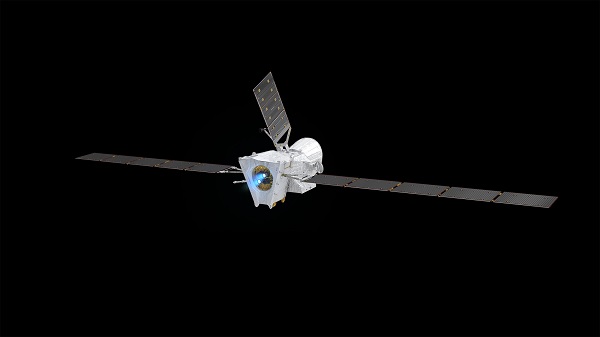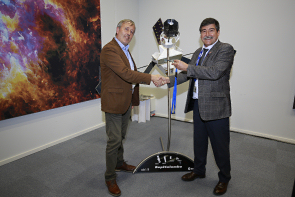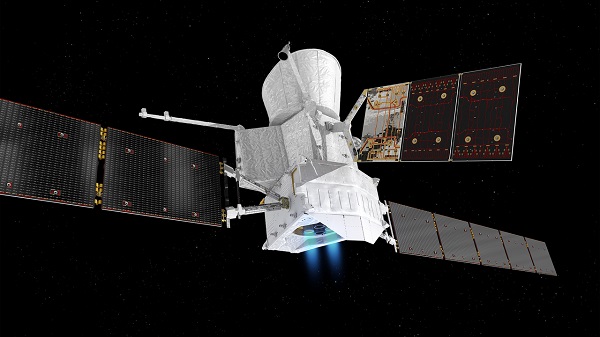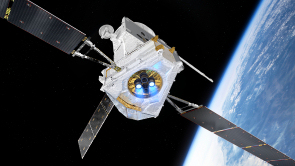BepiColombo is ready for its long cruise
5 April 2019
Following a series of tests conducted in space over the past five months, the ESA-JAXA BepiColombo mission has successfully completed its near-Earth commissioning phase and is now ready for the operations that will take place during the cruise and, eventually, for its scientific investigations at Mercury. |
| BepiColombo in cruise configuration. Credit: ESA/ATG medialab |
BepiColombo started its seven-year long journey to the Solar System's innermost planet on 20 October 2018, lifting off on an Ariane 5 rocket from Europe's spaceport in Kourou, French Guiana.
After completing the launch and early orbit phase on 22 October, an extensive series of in-orbit commissioning activities started. During this near-Earth commissioning phase, which was concluded on 16 December, the European and Japanese mission teams performed tests to ensure the health of BepiColombo's science instruments, its propulsion and other spacecraft platform systems.
On 26 March 2019, a review board confirmed that the overall capabilities and performance at the end of the near-Earth commissioning phase meet the mission requirements.
 |
| Patrick Martin (left) and Ulrich Reininghaus (right). Credit: ESA – R. Palmari |
"We are very pleased with the performance of BepiColombo and proud of the work of all teams who made such a challenging mission a reality", says Ulrich Reininghaus, ESA BepiColombo project manager.
This marks the end of the commissioning activities, and the operations team can focus on routine operations and on preparations for the mission's first planetary gravity assist next year.
"BepiColombo has successfully passed its health check and is now officially in operations," says ESA mission manager Patrick Martin.
The mission comprises two science orbiters: ESA's Mercury Planetary Orbiter (MPO) and JAXA's Mercury Magnetospheric Orbiter (MMO). The ESA-built Mercury Transfer Module (MTM) will carry the orbiters to Mercury using a combination of solar electric propulsion and gravity assist flybys – one of Earth, two at Venus, and six at Mercury – prior to MPO and MMO orbit insertions.
The first electric propulsion 'arc' started on 17 December, after verification of the four individual thrusters as well as the so-called 'twin firing' configuration, operating two thrusters in close proximity for a prolonged period of time, which was monitored closely by the operations engineers. The solar propulsion arc – the first in a series of 22 – was successfully completed in early March.
 |
| BepiColombo electric propulsion. Credit: ESA/ATG medialab |
"Solar electric propulsion is one of the key flight challenges of this complex mission, and we are very pleased to see the system now in full operation," says Elsa Montagnon, BepiColombo spacecraft operations manager.
Since launch, BepiColombo has already covered over 450 million km – just about four percent of the total distance it will have to travel before arriving at Mercury at the end of 2025. The composite spacecraft is now some 50 million km from Earth, and telecommands take about three minutes to reach it.
The near-Earth commissioning activities for all science instruments on both orbiters have been completed as planned, and both ground segments – on the operations and science sides – are ready to support the next chapter of the mission.
"Besides the health checks that were successfully executed on all instruments, several of them are already operated in full science mode. The instrument teams are ready to go," says ESA project scientist, Johannes Benkhoff.
 |
| BepiColombo Earth flyby. Credit: ESA/ATG medialab |
In the coming weeks, the BepiColombo teams will investigate some remaining issues and carry out high-voltage related instrument checks while looking forward to the next major mission milestone, as the spacecraft will come back to some 11 000 km from Earth for a flyby on 13 April 2020.
Later next year, in October, BepiColombo will perform the first of its two flybys of Venus – the second planned for August 2021. These will provide an exciting opportunity to operate some of the instruments on both orbiters and to collect scientifically valuable data to further study this fascinating planet while en route to the mission's destination – Mercury.
For more information, please contact:
Markus Bauer
ESA Science Programme Communication Officer
Tel: +31 71 565 6799
Mob: +31 61 594 3 954
Email: markus.bauer![]() esa.int
esa.int
Daniel Scuka
ESA Programme Communication Officer
Operations & Space Safety
Email: daniel.scuka![]() esa.int
esa.int




